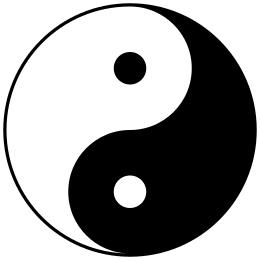What is your source, that yin and yang being perfectly balanced is "the highest order"? In Chinese philosophy wuji is beyond the more modern taijitu-symbol, sometimes placed in the center of other yin-yang symbols or the taijitu.
Naturally I'm speaking is generalities. Although to the extent that it doesn't distract from the topic of the thread I'm willing to go into whatever specificity you like about how eastern mysticism relates to the topic at hand.
The basic idea of the thread revolves around the concept of the duality inherent in the natural world, light/dark, male/female, good/evil, life/death, law/spirit, Jew/Gentile, as opposed to a spiritual order that transcends all natural duality. Naturalistic theologies and philosophies attempt to establish harmony between natural polar oppositions without destroying the balance between the two elements creating the polarity.
For instance, a naturalistic Judaism seeks harmony between Jew and Gentile without destroying the fabric of their difference (i.e., the law of
shatnez, forbidding the direct mixture of unlike properties). Pharisaical Judaism seeks a unity that doesn't dissolves the very difference that gives the terms ("Jew" and "Gentile") their meaning. Likewise, naturalistic Judaism seeks a unity between male and female that doesn't dissolve, or eliminate, the biological difference that gives male and female their identity. St. Paul is reckoned the archenemy of naturalistic (Pharisaical) Judaism for his revelation that in a truly spiritual order there's neither Jew nor Gentile, male nor female. In one of his most cryptic statements he encourages the natural born Jew to go all the way and cut through to the bone of the truth coiled around the crux of the symbolism inherent in the founding ritual.
Which is to say that in the naturalistic form of Pharisaical Judaism the very ritual upon which
Judaism is founded, ritualistic emasculation under the
chuppah (creating the
"hatan"), fails to eliminate the mediator between male and female, which, the mediator, is the very flesh the Jewish sage admits is the natural distinction between male and female. The founding ritual ritualistically removes the "flesh" that creates the distinction between male and female without going all the way, ala St. Paul, in which case there would be no fleshly distinction between bridegroom (
hatan) and bride.
But St. Paul goes further than that. In other places he implies that rather than "going all the way" under the
chuppah (instead of in the bedroom), the natural-born Jew creates a meme (the scar that should represent emasculation) which becomes the natural distinction between Jew and Gentile. With one slip of the scribe's and the mohel's wrist, the blade that should create a new spiritual order free of the distinctions between male and female, Jew and Gentile, instead creates a mark that contrary to dissolving the distinctions (male/female, Jew/Gentile), actually magnifies the differences to the point that women are separated from men in the synagogue and marked flesh is not allowed to enter into the flesh of those not naturally born from flesh so marked.
The very cutting that should eliminate the distinction between male and female, Jew and Gentile, has become the "mark" (of circumcision) that glorifies the distinctions as though the glory of the natural world order is merely the proper balance between male and female, Jew and Gentile, and not, as St. Paul implied, the complete and total obliteration of such disunity.
John

